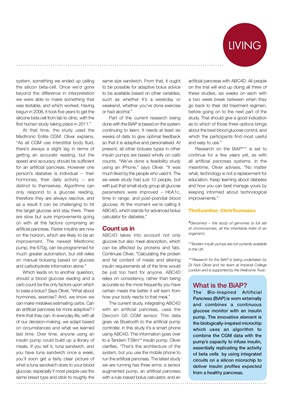
KITLIVING
system, something we ended up calling
the silicon beta-cell. Once we'd gone
beyond the difference in interpretation
we were able to make something that
was testable, and which worked. Having
begun in 2006, it took five years to get the
silicone beta cell from lab to clinic, with the
first human study taking place in 2011."
At that time, the study used the
Medtronic Enlite CGM. Oliver explains,
"As all CGM use interstitial body fluid,
there's always a slight lag in terms of
getting an accurate reading, but the
speed and accuracy should be sufficient
for an artificial pancreas. However one
person's diabetes is individual -- their
hormones, their daily activity -- are
distinct to themselves. Algorithms can
only respond to a glucose reading,
therefore they are always reactive, and
as a result it can be challenging to hit
the target glucose and stay there. There
are slow but sure improvements going
on with all the factors comprising an
artificial pancreas. Faster insulins are now
on the horizon, which are likely to be an
improvement. The newest Medtronic
pump, the 670g, can be programmed for
much greater automation, but still relies
on manual bolusing based on glucose
and carbohydrate information alone."
Which leads on to another question,
should a blood glucose reading and a
carb count be the only factors upon which
to base a bolus? Says Oliver, "What about
hormones, exercise? And, we know we
can make mistakes estimating carbs. Can
an artificial pancreas be more adaptive? I
think that they can. In everyday life, with all
of our decision-making, we adapt based
on circumstances and what we learned
last time. Over time, anyone using an
insulin pump could build up a library of
meals. If you tell it, tuna sandwich, and
you have tuna sandwich once a week,
you'll soon get a fairly clear picture of
what a tuna sandwich does to your blood
glucose, especially if most people use the
same bread type and stick to roughly the
same size sandwich. From that, it ought
to be possible for adaptive bolus advice
to be available based on other variables,
such as whether it's a weekday or
weekend, whether you've done exercise
or had alcohol."
Part of the current research being
done with the BiAP is based on the system
continuing to learn. It needs at least six
weeks of data to give optimal feedback
so that it is adaptive and personalised. At
present, all other boluses types in other
insulin pumps are based wholly on carb
counts.
"We've done a feasibility study using
an iPhone," says Oliver. "It was much liked
by the people who used it. The six-week
study had just 10 people, but with just that
small study group all glucose parameters
were improved - HbA1c, time in range,
and post-prandial blood glucose. At the
moment we're calling it ABC4D, which
stands for advanced bolus calculator for
diabetes."
Count us in
ABC4D takes into account not only
glucose but also meal absorption which
can be affected proteins and fats.
Continues Oliver, "Calculating the protein
and fat content of meals and altering
insulin requirements all of the time would
be just too hard for anyone. ABC4D
relies on consistency, rather than being
accurate so the more frequently you have
certain meals the better it will learn from
how your body reacts to that meal."
The current study, integrating ABC4D
with an artificial pancreas, uses the
Dexcom G5 CGM sensor. This data
goes via Bluetooth to the artificial pump
controller, in this study it's a smart phone
using ABC4D. This information goes over
to a Tandem T:Slim** insulin pump. Oliver
clarifies, "That's the architecture of the
system, but you use the mobile phone to
run the artificial pancreas. The latest study
we are running has three arms: a sensor
augmented pump, an artificial pancreas
with a rule-based bolus calculator, and an
artificial pancreas with ABC4D. All people
on the trial will end up doing all three of
these studies, six weeks on each with
a two week break between when they
go back to their old treatment regimen,
before going on to the next part of the
study. That should give a good indication
as to which of those three options brings
about the best blood glucose control, and
which the participants find most useful
and easy to use."
Research on the BiAP*** is set to
continue for a few years yet, as with
all artificial pancreas systems. In the
meantime, Oliver advises, "No matter
what, technology is not a replacement for
education. Keep learning about diabetes
and how you can best manage yours by
keeping informed about technological
improvements."
TheGuardian_ChrisToumazou
*Genomics - the study of genomes (a full set
of chromosomes, all the inheritable traits of an
organism).
What is the BiAP?
The Bio-Inspired Artificial Pancreas (BiAP) is worn externally and combines a
continuous glucose monitor that reads the user's interstitial fluid sugar level.
It also has an insulin pump that infuses the insulin into the body. The most
innovative element is the biologically-inspired microchip which uses an algorithm
to combine the CGM data with the pump's capacity to infuse insulin. This has
enabled the research team to replicate the activity of the beta cells of the
pancreas using integrated circuits on a silicon microchip. With this they have
been able to "deliver insulin profiles expected from a healthy pancreas".